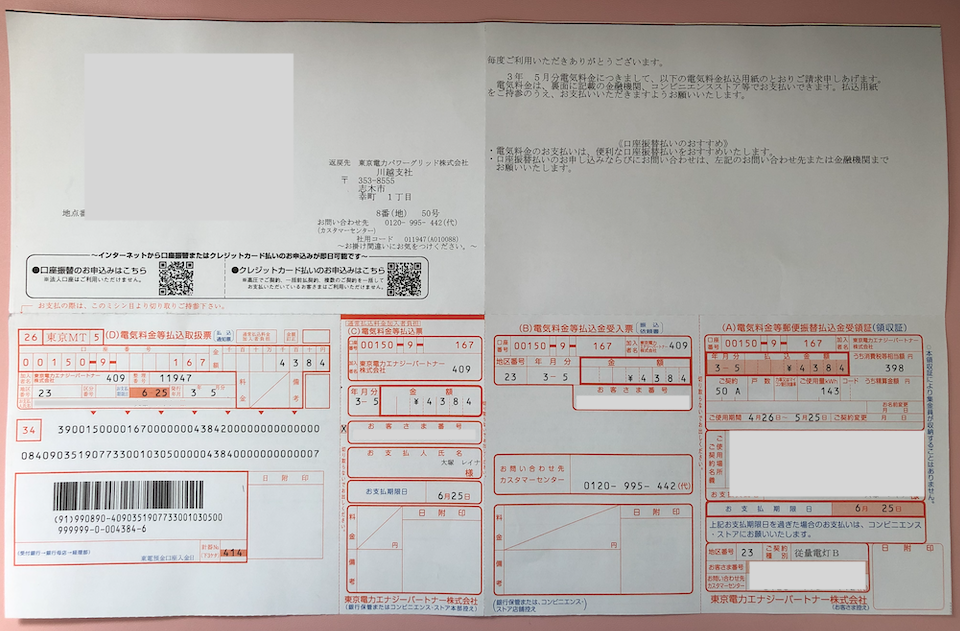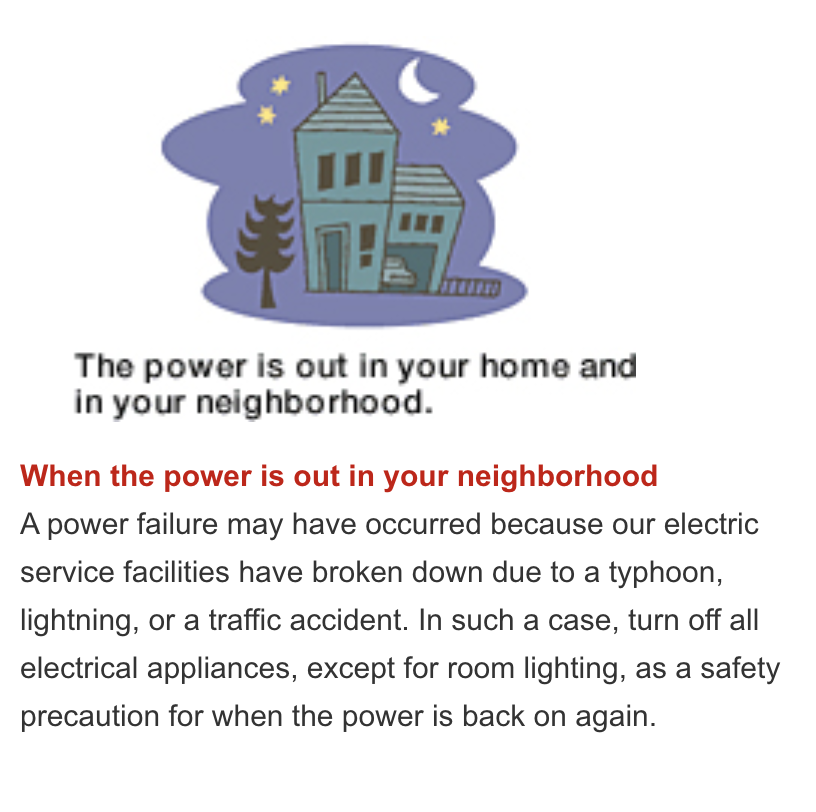
Ah, the TEPCO (Tokyo Electric Power Company) bill. It looks like an engineering student’s final project to be submitted to the professor. Have you ever found yourself heading to the nearest combini (convenience store), billing in hand, with more than enough cash just in case the largest amount stated on the paper wasn’t the final amount? Breaking down those complex-looking sections can help you decipher important information such as your energy consumption, what kind of plan you have, how much you need to pay, and by when.
First, you’ll receive advance notice of your billing. It’s one of those pamphlets that you peel off on multiple sides.

It contains all the information you need, such as the energy consumption reading, how much you need to pay, and by when. You also usually find some extra advertisements at the back, such as 24-hour customer support for an added fee. Since this is just an advance notice, you can’t pay the bill yet at the convenience store (if this is your preferred payment method). The paper, however, also serves as a receipt if your electricity bill is paid through an account transfer system. Wait about a week, and the payable billing will arrive, although sometimes the notice can arrive simultaneously as the actual billing.
Here’s a sample of the billing from TEPCOs’ website:

Here’s the corresponding information per number:
- Electricity consumption
- Amount to be billed
- A breakdown of the amount to be billed1
- Planned date of account transfer
- Telephone number of TEPCO Customer Center
- Customer number
- Your present contract ampere
- Receipt for payment of electricity bill through account transfer
- Payment received for the previous month
- Billing period for the month indicated
- Address of electricity consumption
1. If you owe less than ¥1,000, the billing will be combined with the next month. Furthermore, if you just moved into an apartment that hasn’t been used or you were away and didn’t use any electricity, you only have to pay half of the indicated basic fee or demand charge
A copy of the most recent billing looks like the one below.

How is the rate calculated?
If you’re someone who likes to gauge just how much electricity you’re consuming, you can also verify how the rate is calculated. The formula for calculating electricity charges is the basic fee (demand charge) plus the energy charge rate multiplied by the monthly energy consumption, considering fuel cost adjustments, plus any renewable energy surcharges.

According to provisions, the renewable energy power promotion surcharge is calculated based on the unit price set every fiscal year. Meanwhile, the fuel cost adjustment system is designed to meet changes in recent fuel costs so that the electricity billing will cover any rise or fall due to fluctuations in the foreign exchange rate or energy prices of crude oil, LNG (liquefied natural gas), or coal.
Figuring out your contract ampere
The contract ampere is based on the electric current (ampere) used by the customer. If you consume more than the stated contract, the breaker will be cut off automatically. We’ve had this happen while staying at a 1K apartment. When our oven, induction stove, television, and computers are running on top of the other appliances, the breaker will go off.
According to TEPCO, your present contract ampere is represented by the color of the breaker. The corresponding ampere range and demand charge are as follows:

If you don’t use up as much electricity every month or need more, you can contact TEPCO’s customer center for the change. You set an appointment, and a service technician will visit to change the ampere breaker for free. More information on the contract category and corresponding rates can be found here.
Your payment options
Now that you know what your billing means, it’s time to pay. TEPCO accepts multiple payment methods to make things more convenient for its clients. You can settle your bill personally at the nearest post office, bank, or convenience stores like 7/11, Lawson, and Family Mart. You also have the option of going for a more paperless route by paying through automatic transfer payment from your bank. TEPCO also accepts credit card payments and caters to most of the major credit card companies in Japan.
Did you know that an automatic bank transfer gets you a small discount? It’s about ¥55 per month now, although it depends on the contract you are subscribed to. Convenience plus small savings. Who wouldn’t want that?
Troubleshooting your electricity
If you find yourself in a pickle and experience a power outage, there are a few simple steps illustrated by TEPCO to decipher the cause of the blackout. The infographics below might help. There are three circumstances explained: outage at specific parts of your home, power failure in your entire home, or a blackout in your neighborhood.


As mentioned earlier, when the breaker turned off in our old apartment due to overconsumption, we would simply turn off some gadgets or appliances and turn the breaker back on. If that doesn’t work, the leakage circuit breaker might have gone out. In that case, you can contact TEPCO for assistance or follow the steps below:
- Make sure that the leakage circuit breaker is switched off
- Turn off all the no-fuse circuit breakers
- Make sure that the ampere breaker is switched on
- Switch on the leakage circuit breaker
- Turn on the no-fuse circuit breakers one by one
The image below should give you an idea of what the leakage and no-fuse circuit breakers are, more or less.


When you call TEPCO customer support for assistance, you will need to give your name, address, registered phone number, and detailed explanation of the issue.
Whether you’re planning to move out or move into a new place, change payment methods, have questions regarding your electricity bill, or wish to upgrade or downgrade your contract, you can call support or go to TEPCO’s website for guidance. The good news is that the information is available in English, too! Hopefully, this guide has answered your TEPCO questions and helped you understand that electricity bill better.















